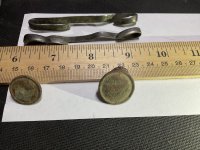Black Duck
Sr. Member
Here is another piece of equipment that is just weak in the field of marine archaeology
Bill Seliger wrote this explanation for one of our on going reports we are doing.
Good job Bill
High Pressure Water Jetting Explanation
High pressure water jetting is one of several methods that has been utilized by shipwreckinvestigators once a shipwreck site is located under sediment. A high pressure water pump onthe surface is connected to a hose with a pipe connected to the other end. The pipe is taken tothe seafloor and pushed into the sediment, the high pressure water which comes out of theend of the pipe literally jets a hole into the ground. It is useful for pinpointing large objectswhich are buried in several feet of sediment to minimize excavation or for determining the sizeof a very large object without excavating it. It is however, very time consuming, and provideslimited information on the buried object and is not really effective on deeply buried objects.We experimented with this equipment in the Dominican Republic during the 2011-2012 season.Aquascan Intl. fabricated a water jet probe and sent it to us for testing. The probe had a pulseinduction metal detector built into the end which enabled the user to actually listen for metallicobjects as he jetted down. We came to the conclusion that the jet probe was extremely timeconsuming and provided very limited information on the objects encountered. It wasabsolutely unusable in rocky areas, or areas with ancient dead coral deposits and was difficultto use in areas with strong current or limited visibility. Once an object was encountered by theprobe, the object still had to be excavated with either a dredge, airlift or blower in order todetermine what the object was.
At Cape Canaveral we have identified several square miles which contain scattered objects. Weuse a hand-held proton magnetometer to pinpoint the object which is then excavated with aprop-wash deflection system. A Jet probe is literally a pin-pointing device which would servethe same purpose as the magnetometer but be far less effective and much more timeconsuming. A jet probe also disturbs the sediment by boring down into it, whereas themagnetometer does not. Once an item is pinpointed regardless of what method is used, theobject still needs to be excavated for identification.
Once an intact shipwreck or ballast-pile is encountered a jet probe could be used to delineatethe shipwreck boundaries but once again, the jet probe will provide very little informationother than the location of an object. In essence you are looking at a 4” diameter area on theseafloor or artifact which is completely insufficient for archaeological identification and studypurposes.


This is just not a tool of choice but I guess it has some use, the tube is 8 ft + long
Bill Seliger wrote this explanation for one of our on going reports we are doing.
Good job Bill
High Pressure Water Jetting Explanation
High pressure water jetting is one of several methods that has been utilized by shipwreckinvestigators once a shipwreck site is located under sediment. A high pressure water pump onthe surface is connected to a hose with a pipe connected to the other end. The pipe is taken tothe seafloor and pushed into the sediment, the high pressure water which comes out of theend of the pipe literally jets a hole into the ground. It is useful for pinpointing large objectswhich are buried in several feet of sediment to minimize excavation or for determining the sizeof a very large object without excavating it. It is however, very time consuming, and provideslimited information on the buried object and is not really effective on deeply buried objects.We experimented with this equipment in the Dominican Republic during the 2011-2012 season.Aquascan Intl. fabricated a water jet probe and sent it to us for testing. The probe had a pulseinduction metal detector built into the end which enabled the user to actually listen for metallicobjects as he jetted down. We came to the conclusion that the jet probe was extremely timeconsuming and provided very limited information on the objects encountered. It wasabsolutely unusable in rocky areas, or areas with ancient dead coral deposits and was difficultto use in areas with strong current or limited visibility. Once an object was encountered by theprobe, the object still had to be excavated with either a dredge, airlift or blower in order todetermine what the object was.
At Cape Canaveral we have identified several square miles which contain scattered objects. Weuse a hand-held proton magnetometer to pinpoint the object which is then excavated with aprop-wash deflection system. A Jet probe is literally a pin-pointing device which would servethe same purpose as the magnetometer but be far less effective and much more timeconsuming. A jet probe also disturbs the sediment by boring down into it, whereas themagnetometer does not. Once an item is pinpointed regardless of what method is used, theobject still needs to be excavated for identification.
Once an intact shipwreck or ballast-pile is encountered a jet probe could be used to delineatethe shipwreck boundaries but once again, the jet probe will provide very little informationother than the location of an object. In essence you are looking at a 4” diameter area on theseafloor or artifact which is completely insufficient for archaeological identification and studypurposes.
This is just not a tool of choice but I guess it has some use, the tube is 8 ft + long



